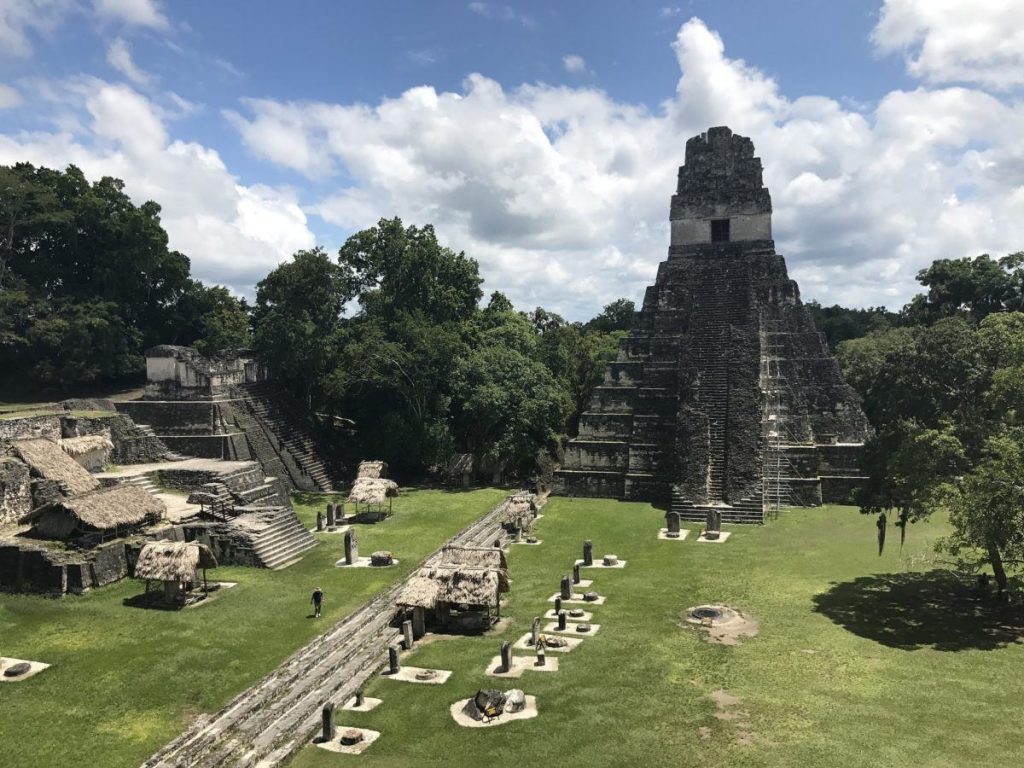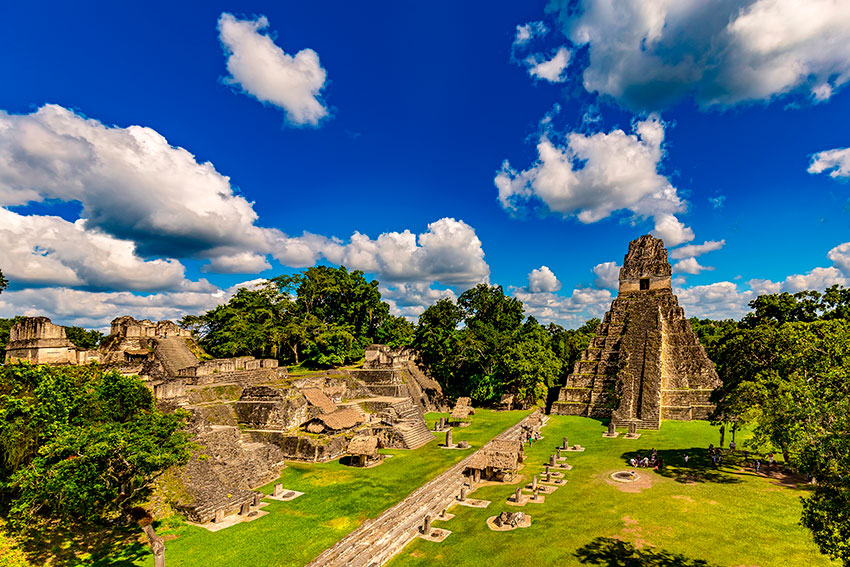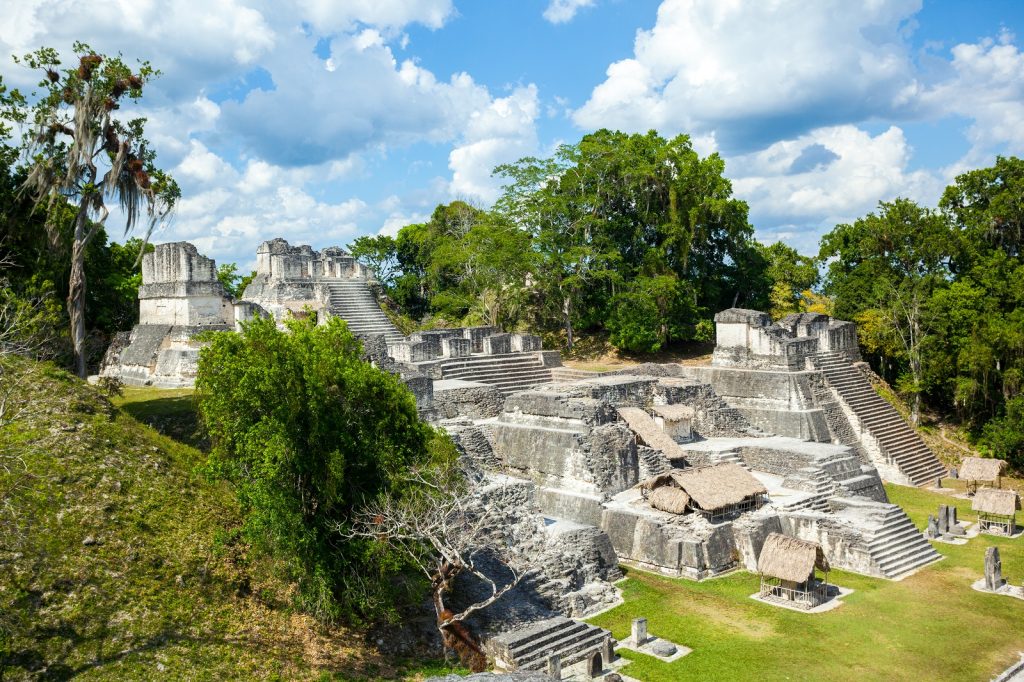Tikal: History and Meaning
Tikal National Park, located in the heart of the Guatemalan jungle, is a living testimony of the grandeur of the Mayan civilization. This archaeological site, one of the most important in the Mayan culture, offers an impressive journey through time. Founded in the 4th century BC, Tikal reached its peak between the 3rd and 4th centuries AD, becoming one of the most important political, scientific and economic centers of the Mayan civilization.

The city was built respecting the natural topography, demonstrating advanced Mayan engineering and architecture.
The temples and acropolis rise majestically above the jungle, offering a spectacular view and serving as a reminder of human ingenuity in harmony with nature. Tikal was not only a ceremonial center, but also a nucleus of Mayan astronomical, mathematical and calendrical development.
The discovery of Tikal in the 19th century opened a window into the understanding of Mayan society, its hierarchy, religion and daily life.
Excavations have revealed complex networks of causeways, water collection systems and urban planning that attest to the sophistication of its inhabitants.
Tikal is a site inscribed on the UNESCO World Heritage List, not only for its historical and cultural significance, but also for its biodiversity.
The park is located within the Mayan Biosphere Reserve, home to a wide variety of flora and fauna, including endangered species such as the jaguar and numerous endemic birds.
Visiting Tikal is to immerse yourself in the mystery of a disappeared civilization, admire its architectural legacy and understand the deep connection between the Mayans and their natural environment.
The experience of walking among the ruins, listening to the sound of howler monkeys and watching toucans fly, transports visitors to another era, offering not only a history lesson, but also a reminder of the importance of preserving our heritage. cultural and natural.
This first approach to Tikal lays the foundation to further explore its wonders, how to get there, what to see and how to responsibly enjoy this Guatemalan treasure.
The story of Tikal is a tale of rise, dominance, and eventual abandonment, which continues to captivate historians, archaeologists, and travelers alike.
The majesty of its temples, the complexity of its society and the beauty of its surroundings make Tikal an essential destination for any lover of history and nature.
How to Get to Tikal: Options and Tips
Traveling to Tikal from Guatemala City requires planning, but the trip is part of the adventure. The most common way to get to Tikal is by flying from Guatemala City to Flores, the closest access point to the ruins.
Several airlines operate daily flights to Mundo Maya International Airport in Flores, lasting approximately one hour.
Upon arriving in Flores, visitors can opt for private or public transportation to cover the remaining 63 kilometers to Tikal National Park.
For those who prefer the road, there are bus and shuttle services that make the trip from Guatemala City to Flores.
This option is cheaper but also longer, lasting approximately 8 to 10 hours. It is important to choose a reliable transportation company and consider traveling at night to optimize time.
Another alternative is car rental, which offers the freedom to explore at your own pace, not only Tikal but also the surrounding area. The road to Tikal is in good condition, but it is recommended to familiarize yourself with local traffic regulations and appropriately plan stops for fuel and rest.
Planning your trip to Tikal
Book your flight or ground transportation in advance, especially in high season.
Check departure and arrival times to coordinate transportation from Flores to Tikal.
If you opt for public transportation from Flores, explore the options of buses or buses that leave regularly to the park.
For a more enriching experience, consider hiring a tour guide who will not only provide you with transportation but also valuable knowledge about the site and its history.
Anticipation and preparation are key to fully enjoying your visit to Tikal.
This journey is not only a geographical displacement but also a jump in time towards one of the most fascinating civilizations in human history.
Upon arriving at Tikal, you will find a world where nature and Mayan architecture intertwine, creating a unique landscape waiting to be explored.

Top Attractions and Activities
Tikal National Park is home to impressive structures that tell the story of one of the most intriguing civilizations in the world. Among its main attractions are:
The Great Plaza: Heart of Tikal, this complex is famous for its majestic pyramids and temples, including Temple I (Temple of the Great Jaguar) and Temple II (Temple of the Masks), which frame the plaza. This place was not only the ceremonial but also the social center of Tikal, offering a space for religious events and community gatherings.
The Lost World (Astronomical Complex): This set of structures reveals the advanced astronomical knowledge of the Mayans.
The Pyramid of the Lost World is particularly notable, functioning as an observatory that marked the equinoxes and solstices, essential for agriculture and religious ceremonies.

Temple IV: Known as the Temple of the Double-Headed Serpent, it is the tallest structure in Tikal and offers panoramic views of the jungle and ruins.
Climbing to its summit is an unforgettable experience, allowing visitors to appreciate the vastness of the site and its integration with the surrounding nature.
In addition to exploring these and other monumental structures, Tikal offers a wide range of activities:
Guided walks: Participating in tours with local guides enriches the visit, providing historical contexts and anecdotes about Mayan life.
Bird watching: The reserve is a paradise for bird watchers, with endemic and migratory species that make Tikal their home.
Photography: Stunning views and rich biodiversity provide unique opportunities to capture magical moments.
To make the most of your visit, consider these tips:
Start your tour early in the morning to avoid the midday heat and increase your chances of spotting wildlife.
Bring water, a hat, sunscreen, and insect repellent for your comfort and protection.
Please stay on marked trails to preserve the site and your own well-being.
A visit to Tikal is more than a tour of ancient ruins; It is an immersion in a culture that, despite its apparent disappearance, continues to have a profound impact on the contemporary world.
The combination of architectural wonders, astronomical knowledge and respect for nature make Tikal a place of constant learning and wonder. More places to visit in Guatemala in your next trip.